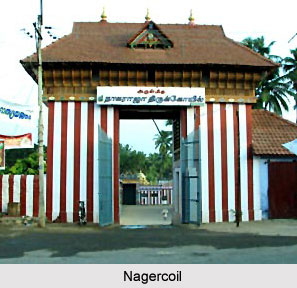 Kanniyakumari is situated at the southern tip of India. In a way it suggests the last edge of the country. Here too the sub-continent is protected by a host of gods and goddesses. There are several temples here that reflect the religious beliefs and the customs of the South India people. Pilgrims from all over the world drop come here to take a look at these temples. There are shrines around Kanyakumari too.
Kanniyakumari is situated at the southern tip of India. In a way it suggests the last edge of the country. Here too the sub-continent is protected by a host of gods and goddesses. There are several temples here that reflect the religious beliefs and the customs of the South India people. Pilgrims from all over the world drop come here to take a look at these temples. There are shrines around Kanyakumari too.
On the shores, there are shrines dedicated to Lord Ganesha, Adi Sankara and Swami Vivekananda. There are three Siva temples: Kashi Viswanathar and Guhanadiswarar shrines on the main road and Viswanathar shrine at the Sannadhi Street.
Suchindrum: This important pilgrim centre is situated en route to Nagercoil and at a distance of 13 km from Kanyakumari. The temple enshrines Sri Sthanumalaya, the Trinity of God (Shiva, Vishnu and Brahma).
Suchindrum was known as Gyanaranya. According to a legend, Atri Maharishi and his wife Anasuya, known for her chastity, had their hermitage here. Anasuya could bring rains to the parched land by sprinkling the padha theertham of her husband. When Lakshmi, Saraswathi and Parvathi heard from Narada that a woman had excelled them all in her Pathi Bhakti, they decided to test the chastity of Anasuya.
To satisfy the bidding of their wives, the Trimurtis appeared at the hermitage of Anasuya as old Brahmins seeking alms. When she was about to serve them food, the brahmins told her that they had taken a vow not to have food served by anyone wearing clothes. She sprinkled Atri`s padha theertham on the brahmins, who were immediately transformed into three babies.
Meanwhile, the long absence of the Gods worried the Devis and they approached Anasuya for Mangalya Biksha. Anasuya sprinkled the padha theertham on the babies and the 3 Gods appeared by the side of their partners. The Devas and sages came to Gyanaranya to have darshan of the Trimurtis. When they left, three Swayambu Lingas sprouted at the foot of a Konnai tree.
On either side of this Konnaiyadi shrine are a giant, white Nandi and Garudalwar, facing the sanctums of Sthanumalaya and Vishnu. The Vishnu idol is made of a special mixture of jaggery and mustard. Hence abhisheka is performed only for the processional deity.
Another legend has it that Ahalya, wife of Gautama Rishi, was once disgraced by Indra, who, in turn, was cursed by Gautama. Indra then came to Gyanaranya and did penance till Shiva appeared and purified him. The devouts believe that Indra is still doing puja in the temple at midnight after the `ardhajamapuja.` As Indra was purified at Gyanaranya, the place came to be known as Suchindrum.
 The temple is known for its sculptural wealth as well. The 134-foot-tall gopuram is visible to the pilgrims from a long distance. On the eastern corridor is the shrine of Guru Dakshinamurthi next to Konnayadi. The Vasanta Mandapam is a rare monument of art. The Navagrahas are engraved on the ceiling. During the Vasanta Utsavam in summer the idols of Suchindra Perumal and Uma Devi are placed in the Vasanta Mandapam. There is a majestic Nilakanta Vinayaka or Mukkuruni Pillaiyar.
The temple is known for its sculptural wealth as well. The 134-foot-tall gopuram is visible to the pilgrims from a long distance. On the eastern corridor is the shrine of Guru Dakshinamurthi next to Konnayadi. The Vasanta Mandapam is a rare monument of art. The Navagrahas are engraved on the ceiling. During the Vasanta Utsavam in summer the idols of Suchindra Perumal and Uma Devi are placed in the Vasanta Mandapam. There is a majestic Nilakanta Vinayaka or Mukkuruni Pillaiyar.
On the outer prakaram, there are separate shrines for Cheravasal Sastha, Rama and Lord Muruga. There is an imposing image of Hanuman opposite to Lord Rama`s shrine. It is said to represent the Viswarupa of Hanuman as shown to Sita at Ashoka Vana in Lanka. On the northern corridor, there are four musical pillars cut out of single granite blocks.
Vigneswari (a rare feminine form of Vinayaka), Goddess Aram Valartha Nayaki, Indra Vinayaka, Kala Bhairava and Saakshi Ganapathy are also enshrined within this temple.
The festivals here include the 10 day festivals held in Margazhi (Dec-Jan) and Chitrai (April-May).
Nagercoil: The temple here is dedicated to serpent deity Nagaraja. The sanctum is surrounded by mud walls with a simple thatched roof. The prasadam distributed in this temple is only sand scooped out from the sanctum. It is white in colour for six months and light black for the remaining six months.
There are shrines dedicated to Ananthakrishna and Shiva. Lord Muruga and Devi Durga are enshrined on the prakaram. The garden is known for its Naga flower, believed to be a symbolic representation of Sri Nagaraja.
Devotees throng this temple on Sundays and on Aayilyam (Aslesha) star days with offerings of milk.
Other temples towards Thiruvananthapuram are as follows:
• Thirparappu (40 km)
• Sri Mahadevar
• Thiruvattar (30 km)
• Sri Adi Kesava Perumal
• Keralapuram (25 km)
• Sri Mahadevar
• Padmanabhapuram (20 km)
• Neelakanteswara and Ramaswamy
• Mandaikadu (22 km)
• Bhagavathi Amman
• Kumaracoil (15 km)
• Velimalai Murugan temple











